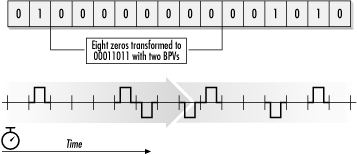B8ZS and Clear Channel Capability
Throughput suffers when the eighth bit is blindly stuffed with a one. Maintaining synchronization requires only that enough pulses are sent down the line. An alternative to straight AMI encoding is to use a scheme based on code word substitution. A second encoding method, called Bipolar with Eight Zero Substitution (B8ZS), is able to transmit an arbitrary bit sequence. When eight consecutive zero bits are scheduled for transmission, a B8ZS transmitter replaces the eight-zero sequence with a code word that contains intentional bipolar violations (BPVs), as shown in Figure 3-4. The code word takes the form of 000VP0VP, where V is a pulse of the same polarity as the previously transmitted pulse and P is a pulse with the opposite polarity as the previous pulse.

Figure 3-4. B8ZS intentional bipolar violation
When B8ZS-capable CSU/DSUs receive the B8ZS code word containing bipolar violations, the code word is replaced with eight consecutive zeros before passing the data on to the user. Transmission at the full line rate is possible with B8ZS because it does not require a portion of the circuit capacity to be used for synchronization. Because the full line rate is available, the telco may refer to the circuit as one that has Clear Channel Capability (CCC), or some similar term. Widespread use of B8ZS is a relatively recent development. Most early ...
Get T1: A Survival Guide now with the O’Reilly learning platform.
O’Reilly members experience books, live events, courses curated by job role, and more from O’Reilly and nearly 200 top publishers.

